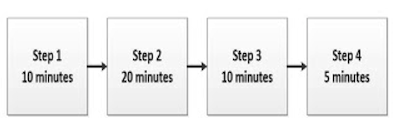
Process Improvement Advice & Best Practices
Why Efficiency Metrics Mislead Us
In the next few postings I want to talk about some of the basics of Continuous Improvement (CI). Not the tools of CI, but rather more of a strategic viewpoint. In other words, some of the principles and guidelines I use in my work which has provided me with a strategy that I can honestly say has never failed to deliver excellent results. But in order for everyone to clearly understand my approach, I need to back up and review some of the basic principles.
Let’s start this discussion with the end product… performance metrics. Why start with the end in mind you may be thinking? In my way of thinking, the key purpose of performance metrics is that they drive behaviors within an organization. For example, if operator efficiency is one of your metrics, what behaviors does it drive? The math used to calculate efficiency is that you have a standard time to complete a task or process step. If you complete this task in exactly the same time that the work standard says it should take, then your efficiency is 100%. On the surface, that seems like something that we all want, but let’s look at this more closely.
The figure above is a simple four-step process used to manufacture a product. Using the definition of efficiency, in order for Step 1 to achieve and sustain 100% efficiency, it would have to produce one product every ten minutes. Simple….right? But, in reality, what would happen after 100 minutes to this process if Step 1 continued producing one part every 10 minutes?
If Step 1 produced one part every 10 minutes and Step 2 could only process 1 part every 20 minutes, then Step 2 would only process 5 of the parts in 100 minutes. Step 3 would process all 5 of these parts as would Step 4. In other words, there would be 5 parts sitting directly in front of Step 2 waiting to be processed. This isn’t exactly what the results would look like, but for demonstration purposes, it will suffice. The point is, if Step 1 continued producing at its maximum capacity, the inventory would continue to build up in front of Step 2. Steps 1 and 2 would be operating at 100% efficiency, but what about Steps 3 and 4? Would it be possible for these two steps to reach 100% efficiency?
The problem with using efficiency as a performance metric is that it is controlled by the step with the least amount of capacity… the system constraint. The total system efficiency will always be less than 100 % simply because of the existence of the system constraint. The system efficiency for our process would be 100 % (Step 1) plus 100 % (Step 2), plus 50 % for Step 3, plus 25 % for Step 4 divided by 4 or 68.75 %. In fact, the only place where efficiency makes any sense at all is in the system constraint which in our process is Step 2.
The origins of operator efficiency lies in traditional cost accounting where the belief exists that everyone should be busy 100 % of the time. In our process it is clear that the operator in Step 3 would only be busy half of the time while the operator in Step 4 would only be busy one quarter of the time! The Cost Accountants would never stand for this and would be looking for manpower reductions!
So if operator efficiency isn’t a good performance metric (except in the constraint), then what is? In other words, how should we measure the performance of our 4-step process? In my next posting we’ll try to answer this question.
Bob Sproull
Bob Sproull is the author of Epiphanized: Integrating Theory of Constraints, Lean and Six Sigma. The book is a business novel and is an attention-grabbing and fast-paced story of the transformation of Barton Enterprises, a manufacturer of fuel tanks for the aviation and defense industry. To learn more about the book, click here >>









